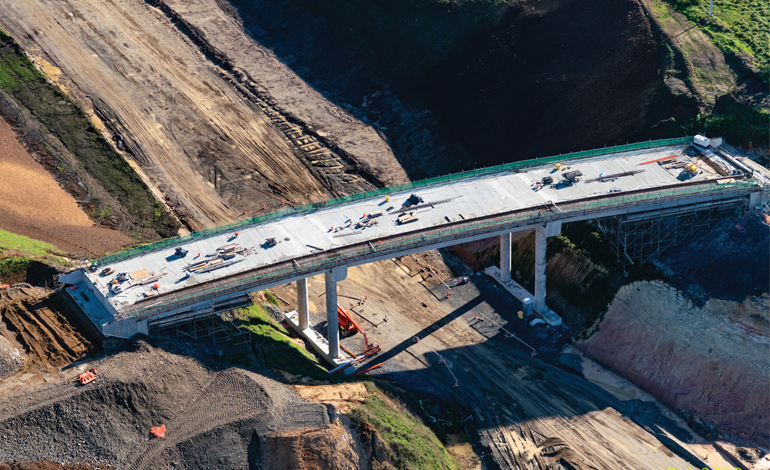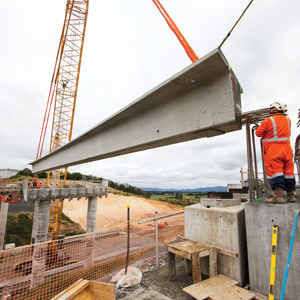The highest bridge to be constructed on the Hamilton section of the Waikato Expressway required 144,000 cubic metres of earth to be excavated beneath it. Richard Silcock talks with those involved in the project.
This 18.8 metre high curved bridge on the Hamilton section of the Waikato Expressway straddles an excavated cutting through what is known locally as the Kay Road ridge, an elevated area of land to the north of Hamilton.
With the expressway cutting through the middle of it, the bridge was required to carry local traffic safely across it and allow the four-lane expressway to pass beneath.
According to NZ Transport Agency’s project manager Darryl Coalter, it is the highest bridge being constructed on this section of the expressway and it can also boast the largest amount of earth excavated on this section.
“That’s enough earth to cover four rugby fields piled five-metres high,” he says.
“It took the contractors some six months to excavate. The bridge is 90-metres long, with one lane in each direction and required 3320 tonnes of concrete and reinforced steel to construct.”
This section of the expressway, which began construction in October 2016, is being built by the City Edge Alliance – a consortium comprising Fletcher Construction, Higgins Contracting, Hicks Bros Civil Construction, Beca as design consultants and Coffey as geotechnical consultants.
Alliance project manager Matt Fairweather says 32 piles were driven 20-metres into the ground for the foundations of the two, 15-metre high bridge piers, each supported by two concrete columns.
“In order to meet the standards required to mitigate damage from earthquakes a considerable amount of ground strengthening was required to prevent any seismic failure,” says Matt. “Three hundred and thirty concrete piles were driven in a square grid to provide ground stabilisation and containment.
“The bridge abutments and retaining walls were also strengthened,” he says.
“Topping the piers are two, 110-tonne concrete crossheads that support 21, 50 tonne, 30-metre-long super-tee bridge beams, all of which were lifted into place using a 300 tonne crawler crane.”
Following the pouring of the concrete deck and construction of median barriers and guardrails the utilities were installed under the bridge deck and included a water main and ducting for power and telecommunications.
Matt says the biggest challenges facing them on this construction was the excavation work, maintaining strict H&S standards, and the lift of the precast elements into position.
“This was due to the variability and instability of the ground which was extremely wet, making the cut slopes on either side of the carriageway prone to slippage.
“We overcame this by redesigning the ground improvements to provide additional seismic stability. The cut slopes are 2.5 to 1.
“With teams working from a height on the bridge superstructure and others carrying out the earthworks below simultaneously it was important that the safety risks were all well managed and protocols followed with each team being aware of what was happening around them.
“Perhaps the most unusual feature of this bridge construction was the method of pre-casting the concrete and structural steel crossheads on site as distinct from off-site and trucking them in.
“This allowed us to save time in the construction and achieve an accuracy of within several millimetres which is pretty impressive.”
The bridge, which has a longitudinal slope of 0.4-degrees and a cross fall of five percent (three degrees), is known as the Kay Road Bridge.
It was opened to traffic on 5 October and is already carrying a large amount of traffic each day. It provides a direct connection between Horsham Downs and Hamilton’s north-eastern suburbs.
At the time of Contractor going to print, six bridges along this section of expressway have been completed, nine are under construction and a further two have yet to be started.
The Mangaonua Gully Bridge near where the expressway runs under SH26 has started construction and is expected to be completed by 2019. At 150-metres long it is the longest bridge in this section and required piles to be bored down 50-metres as it is being built over soft silty sand and swampy land.
This section of the expressway will be constructed using a ‘high-lab’ blend of aggregate. This blend comprises 40mm and 65mm rock and enough fine gravel, sand and cement to bind it together. It is being ‘manufactured’ on-site using a relocatable blending plant that was imported from France.
The final surface will be OGPA (open graded porous asphalt) which provides a much smoother surface and a quieter ride for vehicles compared to chip seal. It will be one of only two sections of road in the country to allow a speed limit of 110 kilometres per hour.
With 1.7 million cubic metres of earth still to be excavated and the base course and pavement to be laid, this $637 million (construction cost), 22-kilometre section of the expressway will open to traffic in late 2020, connecting the Ngaruawahia section with the Tamahere/Cambridge section.
The 102 kilometre long Waikato Expressway will, when completed, stretch from the Bombay Hills to just south of Cambridge.
“When completed the expressway will cut journey times, improve safety for motorists and go towards enhancing the economic growth of the region with a more direct route for vehicles and freight to Auckland’s CBD, port and airport,” says Kaye Clark, the Transport Agency’s Hamilton highways manager.
“It is the final piece of the expressway to start construction and is the biggest road project in the Waikato’s history.”
While some planning and consultation has taken place for extending the expressway a further 16 kilometres beyond Cambridge this is still under re-evaluation by the agency to ensure it aligns with the present government’s land transport policy statement.
THE STATISTICS
This 22-kilometre Hamilton section of the expressway – the longest section of all seven sections which make up the 102-kilometre long Waikato Expressway – will comprise:
• Construction of 17 bridges; the highest being 18.8 metres high (Kay Road) and the longest, the150 metre-long Mangaonua Gully Bridge.
• Five interchanges.
• 4.5 million cubic-metres of earth excavated and shifted.
• 1.3 tonnes of aggregate.
• 500,000 square metres of OGPA.
• 28,450 cubic-metres of concrete.
• 212 kms of road markings.
• 126 kms of fencing.
• 11.4 kms of cycleway and walking paths.
• The planting of 650,000 plants and trees
• Employment of up to 600 people.



